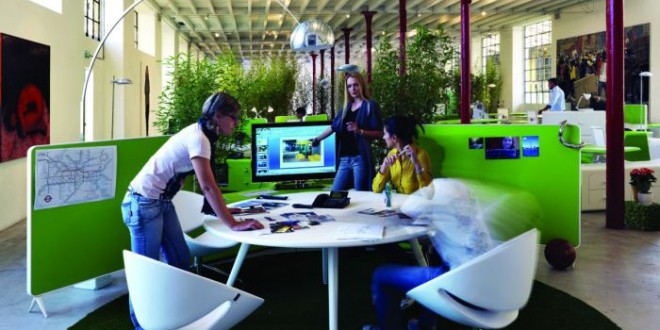LED Lighting and Workplace Productivity
There are numerous reasons to leverage LED lighting in your business. Switching from fluorescent bulbs can bring down energy consumption and reduce your power bill. The financial benefits extend to acquisition and maintenance costs, which are decreased through rebates and less frequent replacements. Investing in LEDs can also strengthen your green credentials, resulting in an improved public image.
Another factor that many companies overlook is the potential for LED technology to enhance employee productivity. Lighting is paramount to creating an optimal work environment. The amount and kind of light that illuminates your office has a major impact on the atmosphere, and it’s something you can use to your advantage. Here’s how.
Cool Down
We tend to associate warm lighting with home and staying indoors on chilly winter weekends. Light bulbs that emit orange and yellow hues promote feelings of calm. While that’s great when you’re slipping into bed or relaxing by the fireplace, it’s not particularly conducive to getting work done.
The opposite is true for tones that fall on the other end of the color spectrum. Lights with blue or white hues that emulate the daytime sky are able to disrupt our circadian rhythm, thus inhibiting drowsiness. That’s why employees who work under LEDs are more alert and active.
Lighten Up
It’s not uncommon for employees to complain about dim lighting – and rightfully so.
Environments that lack sufficient brightness are detrimental to performance for several reasons. This includes:
- Promoting inactivity
- Negatively impacting wakefulness
- Increasing eye strain and headaches
The solution is to simply add more light where it’s needed. Of course, this shouldn’t be done haphazardly. Balance is key. Too much light or the wrong kind of light is no better than too little. Harsh fluorescent bulbs, for instance, are known to cause the same symptoms we mentioned above, including migraines.
Overhead fixtures can be complemented by “task lights” in each individual cubicle, while dimming options can be provided for better flexibility. As mentioned in “The Future of Lighting – LED Lighting for the Win,” beam angle and ceiling materials must also be considered.
Incorporate Nature
LED technologies are certainly valuable when it comes to workplace lighting. However, your means of effectively illuminating the office shouldn’t be entirely artificial.
Where many environments fail to support productivity is in their tendency to make employees feel cramped and restricted. This is why successful workplaces are designed to facilitate sunlight exposure. Aside from aesthetic appeal, having a view of the outside world is highly beneficial to staff performance and overall vitality.
Numerous studies have shown that natural light is able to make employees happier and more productive. They were also observed taking fewer sick days and reporting higher levels of job satisfaction.
You can increase sunlight exposure in several ways. This includes adding skylights and removing obstructions around windows. There may be opportunities to bring more natural light in by changing doors. Mirrors can also be leveraged to bounce light into darker areas.
Take some time to consider how you can incorporate these methods. Your employees are sure to appreciate them.


